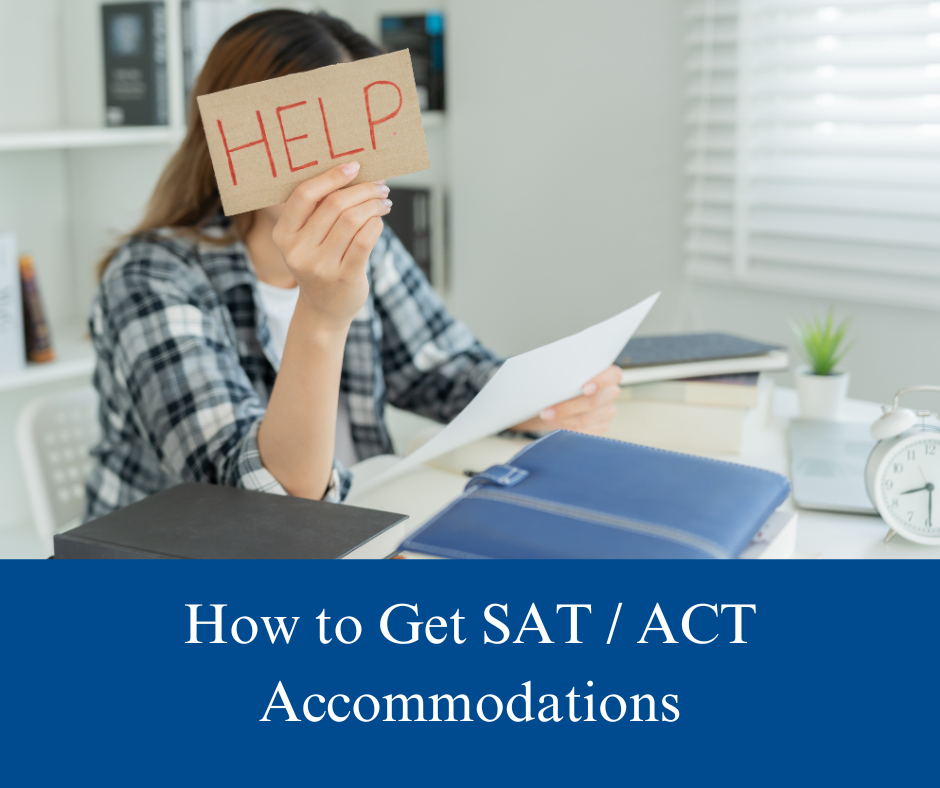
How to Get SAT / ACT Accommodations
In my last blog, I shared a video detailing the spring 2025 changes to SAT accommodations. You can see it HERE. A number of people asked what they needed to do to receive extra time or other accommodations. Today I’m going to outline that process.
Why have accommodations?
High schools and colleges work to accommodate the different needs of their students. Many physical accommodations are more obvious: ramps to allow access for those in wheelchairs or audio, large print, and braille alternatives for those with vision issues. Accommodations are also there for needs that may not be as obvious.
Both ACT and SAT work to provide accommodations on their exams. The most common is 1.5 times time, generally known as extended time. There are a range of other accommodations including double or triple time, a reader (or on digital exams text to speech), or having someone bubble answers on paper and pencil exams.
The goal with any type of accommodation is to attempt to provide a level playing field where all students can compete. When it comes to the SAT and ACT, the goal is to allow all students a fair chance to earn their best scores.
Accommodations are not perfect. They do present some problems of their own, but most students who need accommodations agree that they make the process better.
How do I get accommodations?
Both College Board and ACT have made it very clear that they want to acknowledge accommodations students already have in their high school. This means that students who have extended time at school should receive it on the test.
However, there is a process and approval is not guaranteed.
If you have any type of modifications or accommodations, typically a 504 plan or IEP, at your high school, you should apply to receive accommodations from both SAT and ACT.
You will need to contact your school counselor, or accommodations coordinator, and they will need to submit forms directly to ACT and college board. These forms ask for:
- diagnosis (reason accommodations are needed),
- what the student receives at school, and
- how long these accommodations have been in place
ACT and College Board want to discourage applications from families who are seeking extra time without a legitimate need. One way to do this is to only approve requests for students who have an identifiable need (diagnosis) and have been actively using accommodations in class this school year. Ideally, accommodations would be in place for a year before submitting a request to College Board or ACT.
Once a complete request for accommodations as been submitted, it typically takes 6 to 8 weeks to be processed.
Will it impact how colleges view my scores?
No.
Colleges will not see whether you took the test with accommodations. Your score report will not look any different from the person who did not have accommodations.
Are there any other factors I should consider?
One of the challenges of taking a test like the SAT or ACT is the fact that you are limited on time. Many people hear there is a possibility to get extended time and think it would be a great benefit.
Extended time testing is a double-edged sword. For some students, it is absolutely essential; it is the only way for them to demonstrate close to their potential. But extended time is also a problem. It takes what is already a long and stressful exam and makes it even longer.
Not counting the time it takes to get students seated and started, the SAT, including a 10 minute break, is just short of 2 1/2 hours. with the typical 1.5 X extended time, student should expect the test to take four hours. This includes 50% more time and some additional breaks. For students who find the standard exam to be long, extended time makes it even worse.
Conclusion
Unfortunately, we have a number of high school students struggling with things like dyslexia, ADD/ADHD, anxiety, reading and processing issues, as well as many other physical and mental conditions. Accommodations at school as well as on the SAT and ACT attempt to level the playing field to allow these students to demonstrate their potential.
If you think you would benefit from testing accommodations, understand they are looking for:
- A diagnosed need
- Accommodations in place in school (preferably for a year or more)
- A completed application submitted by your school
You should contact your high school to help you apply. Once you are approved for accommodations. Make sure you practice using your time and other approved tools before going to the actual exam.
Educator Tip
I see a lot of students each year who could benefit from accommodations, both in school and on their college admissions exams. By the time these students come to me for SAT or ACT test prep, it is often too late to start the process.
I wish more junior high parents would think ahead to high school. Even if current classes are manageable and teachers provide a little extra time, when work gets more challenging and students are faced with ACT, AP exams, and the SAT, it might be appropriate to have some accommodations in place.